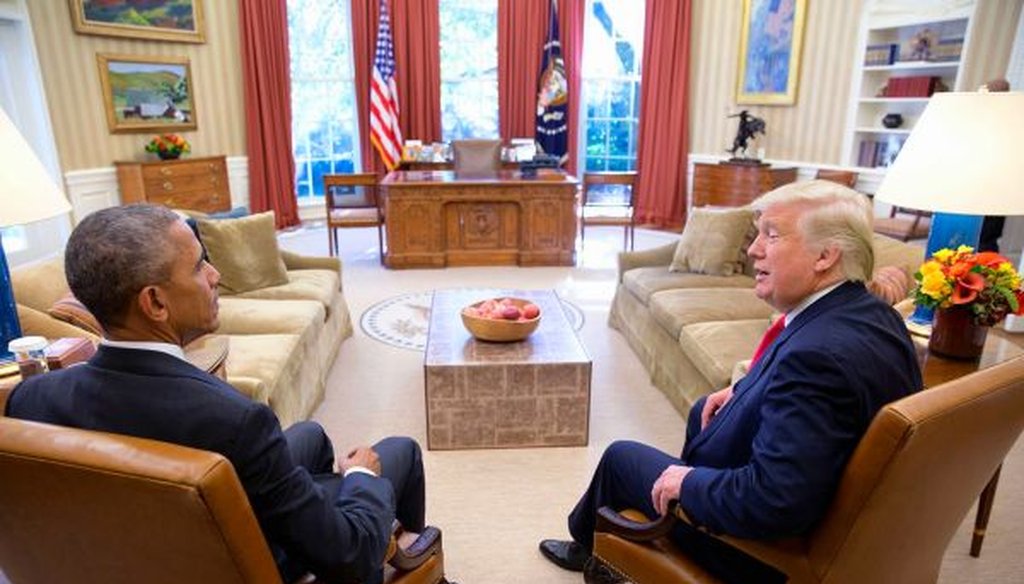

Our only agenda is to publish the truth so you can be an informed participant in democracy.
We need your help.


President Barack Obama and President-elect Donald Trump meet in the Oval Office for the first time. (Wikimedia commons)
Numbers that suggest H1N1 was worse than COVID-19 are misleading.
It’s too early to calculate how deadly the coronavirus will be, but there are signs it’s much worse.
A viral image comparing Presidents Donald Trump and Barack Obama argues that the coronavirus has infected far fewer Americans than did the H1N1 virus, commonly known as swine flu — but that, due to media coverage, reaction to the coronavirus has been overblown.
Here is the full claim:
"President Trump, COVID-19 coronavirus:
U.S. cases: 1,329
U.S. deaths: 38
panic level: mass hysteria.
"President Obama, H1N1 virus:
U.S. cases: 60.8 million
U.S. deaths: 12,469
panic level: totally chill.
"Do you all see how the media can manipulate your life?"
The post, shared on Facebook on March 13, 2020, was flagged as part of Facebook’s efforts to combat false news and misinformation on its News Feed. (Read more about our partnership with Facebook.)
The numbers — for the coronavirus, as of March 12, 2020; and for the swine flu, from April 2009 to April 2010 — are essentially accurate, based on federal government counts.
The numbers in the post actually show a death rate for COVID-19 at more than 100 times that of H1N1.
In any case, it is misleading to compare the two outbreaks at this point in the coronavirus pandemic.
COVID-19 has been in the United States for only about two months; the swine flu figures are for one year, from April 2009 to 2010.
As we’ve reported, it’s difficult this early in an outbreak for public health experts to estimate death rates for the coronavirus; early estimates often undercount mild cases and fail to take into account the fact that some recently infected patients are going to die in the future.
When we published this fact-check, the latest figures from the World Health Organization, for March 17, 2020, showed a surge in COVID-19 cases in the days since the post — 3,503 cases of COVID-19 in the United States, including 58 deaths.
Indeed, it’s too soon to know precisely how deadly COVID-19 is, several experts said.
"The COVID numbers in no way define the problem. We will know the problem after we do many, many tests," said Dr. Myron Cohen, professor of medicine, microbiology and immunology, and epidemiology at the University of North Carolina and director of its Institute for Global Health & Infectious Diseases.
"Comparing flu" generally and COVID-19 "is simply not a good idea," he said. "For flu, the world has vast experience and vaccines. And treatments. And a well-defined mortality rate far lower than COVID. So, as the world faces a new, very contagious fatal infection, it is not surprising that we all feel anxious."
Said Richard Watanabe, professor of preventive medicine and physiology and biophysics at the University of Southern California: "The raw numbers make H1N1 look worse, but in reality the risk of death is much higher for COVID-19."
As for the post’s claim of mass hysteria over coronavirus versus a totally chill response to H1N1, it’s worth noting President Barack Obama’s acting director of health and human services declared H1N1 a public health emergency when the United States had only 20 confirmed cases of H1N1 and no deaths.
Moreover, as FactCheck.org reported, while the H1N1 death toll may sound high, it was far lower than initially expected. It also turned out to have a case fatality rate of just 0.02% — well below even many typical seasonal influenzas.
So, given that indications are the coronavirus death rate is much higher — and given that experts warn the nation’s hospitals are under-prepared to treat the numbers of patients predicted to need care — it makes sense that state and local governments are taking significant action to limit its spread.
The impact in the United States of swine flu might appear much worse than COVID-19, but it lasted for a year, whereas the coronavirus has been here only about two months. And while it’s too soon to calculate how deadly COVID-19 will be, two experts told us it is clearly more deadly than H1N1. This statement contains an element of truth in that the figures quoted were accurate at the time they were posted, but the post ignores critical facts that would give a different impression. We rate this Mostly False.
Correction, March 19, 2020: An earlier version of this story contained a typo in the first paragraph that mischaracterized the claim being made in the viral image. The story has been updated.
Facebook, post, March 13, 2020
PolitiFact, "Donald Trump wrong saying Barack Obama did nothing about swine flu," March 6, 2020
PolitiFact, "Why it’s hard to estimate the coronavirus death rate this early," March 6, 2020
Email, Dr. Myron Cohen, professor of medicine, microbiology and immunology, and epidemiology at the University of North Carolina and director of its Institute for Global Health & Infectious Diseases, March 16, 2020
Email, Richard Watanabe, professor of preventive medicine and physiology and biophysics, University of Southern California, March 16, 2020
International Business Times, "NBA player Rudy Gobert who mocked Coronavirus fears tests positive," March 12, 2020
World Health Organization, "Coronavirus disease 2019 (COVID-19) Situation Report – 46," March 6, 2020
FactCheck.org, "Trump’s H1N1 Swine Flu Pandemic Spin," March 13, 2020
World Health Organization, "Coronavirus disease 2019 (COVID-19) Situation Report – 57," March 17, 2020
In a world of wild talk and fake news, help us stand up for the facts.
